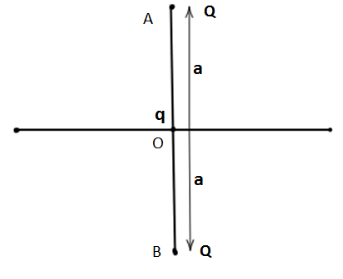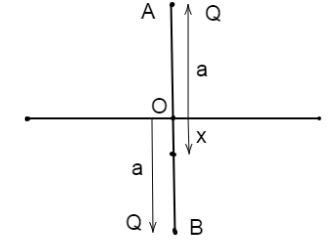
Two charges of equal magnitude $Q$ are placed at a separation $2a$ perpendicular to X- axis. Another charge, $q$ of mass $m$, is placed midway between the two charges on the X−axis. If this charges is displaced from equilibrium state to a distance $x(x < < a)$, then the particle
A. will execute simple harmonic motion about equilibrium position
B. will be oscillating about equilibrium position but not executes simple harmonic motion
C. will not return back to the equilibrium position
D. will stop at equilibrium position
Answer
496.8k+ views
Hint:We can find the nature of the motion of the charge particle by using the concept of necessary conditions to execute simple harmonic motion , Coulomb’s law of and the nature of charge particles.
Formula used:
Electrostatic force between two charges $Q$ & $q$ is given by
$F = \dfrac{1}{{4\pi {\varepsilon _0}}}\dfrac{{Qq}}{{{r^2}}}$
Where, ${\varepsilon _0}$ - permittivity of vacuum and $r$ - distance between the two charges.
Complete step by step answer:
Let us consider two charges of equal magnitude $q$placed at a separation $2a$ perpendicular to the X- axis. Introducing another charge of magnitude $q$midway between the two charges on X – axis. Both the charges at A and B are of the same nature i.e. positive charges. If we place a positive charge midway between these two charges at O on the X-axis, then the particle at O exerts the same force on both end particles A and B.

But, when the particle at O is displaced slightly (say $x$) from its original position then the electrostatic force between the two charges charges, as

${F_1} = \dfrac{1}{{4\pi {\varepsilon _0}}}\dfrac{{Qq}}{{{{(a + x)}^2}}}$ and ${F_2} = \dfrac{1}{{4\pi {\varepsilon _0}}}\dfrac{{Qq}}{{{{(a - x)}^2}}}$
$\Rightarrow {F_2} - {F_1} = \dfrac{{Qq}}{{4\pi {\varepsilon _0}}}\left( {\dfrac{1}{{{{(a - x)}^2}}} - \dfrac{1}{{{{(a + x)}^2}}}} \right)$
Solving we get,
$\Rightarrow {F_2} - {F_1} = \dfrac{{Qq}}{{4\pi {\varepsilon _0}}}\left( {\dfrac{{4ax}}{{{{({a^2} - {x^2})}^2}}}} \right)$
$\therefore {F_1} - {F_2} = - \left( {\dfrac{{Qq}}{{{a^3}\pi {\varepsilon _0}}}} \right)x$
We get , $\therefore \left( {{F_1} - {F_2}} \right)\alpha - x$
Hence, By the definition of simple harmonic motion, we can say that the particle $q$ executes simple harmonic motion about equilibrium position.
Hence, the correct answer is option A.
Note:We must know the concept of simple harmonic motion that restoring force acting on the particle should always be proportional to the displacement of the particle and towards the equilibrium position. Also, make the diagram and place charged particles properly as given in question.
Formula used:
Electrostatic force between two charges $Q$ & $q$ is given by
$F = \dfrac{1}{{4\pi {\varepsilon _0}}}\dfrac{{Qq}}{{{r^2}}}$
Where, ${\varepsilon _0}$ - permittivity of vacuum and $r$ - distance between the two charges.
Complete step by step answer:
Let us consider two charges of equal magnitude $q$placed at a separation $2a$ perpendicular to the X- axis. Introducing another charge of magnitude $q$midway between the two charges on X – axis. Both the charges at A and B are of the same nature i.e. positive charges. If we place a positive charge midway between these two charges at O on the X-axis, then the particle at O exerts the same force on both end particles A and B.

But, when the particle at O is displaced slightly (say $x$) from its original position then the electrostatic force between the two charges charges, as

${F_1} = \dfrac{1}{{4\pi {\varepsilon _0}}}\dfrac{{Qq}}{{{{(a + x)}^2}}}$ and ${F_2} = \dfrac{1}{{4\pi {\varepsilon _0}}}\dfrac{{Qq}}{{{{(a - x)}^2}}}$
$\Rightarrow {F_2} - {F_1} = \dfrac{{Qq}}{{4\pi {\varepsilon _0}}}\left( {\dfrac{1}{{{{(a - x)}^2}}} - \dfrac{1}{{{{(a + x)}^2}}}} \right)$
Solving we get,
$\Rightarrow {F_2} - {F_1} = \dfrac{{Qq}}{{4\pi {\varepsilon _0}}}\left( {\dfrac{{4ax}}{{{{({a^2} - {x^2})}^2}}}} \right)$
$\therefore {F_1} - {F_2} = - \left( {\dfrac{{Qq}}{{{a^3}\pi {\varepsilon _0}}}} \right)x$
We get , $\therefore \left( {{F_1} - {F_2}} \right)\alpha - x$
Hence, By the definition of simple harmonic motion, we can say that the particle $q$ executes simple harmonic motion about equilibrium position.
Hence, the correct answer is option A.
Note:We must know the concept of simple harmonic motion that restoring force acting on the particle should always be proportional to the displacement of the particle and towards the equilibrium position. Also, make the diagram and place charged particles properly as given in question.
Recently Updated Pages
Master Class 12 English: Engaging Questions & Answers for Success

Master Class 12 Business Studies: Engaging Questions & Answers for Success

Master Class 12 Economics: Engaging Questions & Answers for Success

Master Class 12 Social Science: Engaging Questions & Answers for Success

Master Class 12 Maths: Engaging Questions & Answers for Success

Master Class 12 Chemistry: Engaging Questions & Answers for Success

Trending doubts
What are the major means of transport Explain each class 12 social science CBSE

Which are the Top 10 Largest Countries of the World?

Draw a labelled sketch of the human eye class 12 physics CBSE

Explain sex determination in humans with line diag class 12 biology CBSE

Explain sex determination in humans with the help of class 12 biology CBSE

Differentiate between homogeneous and heterogeneous class 12 chemistry CBSE




